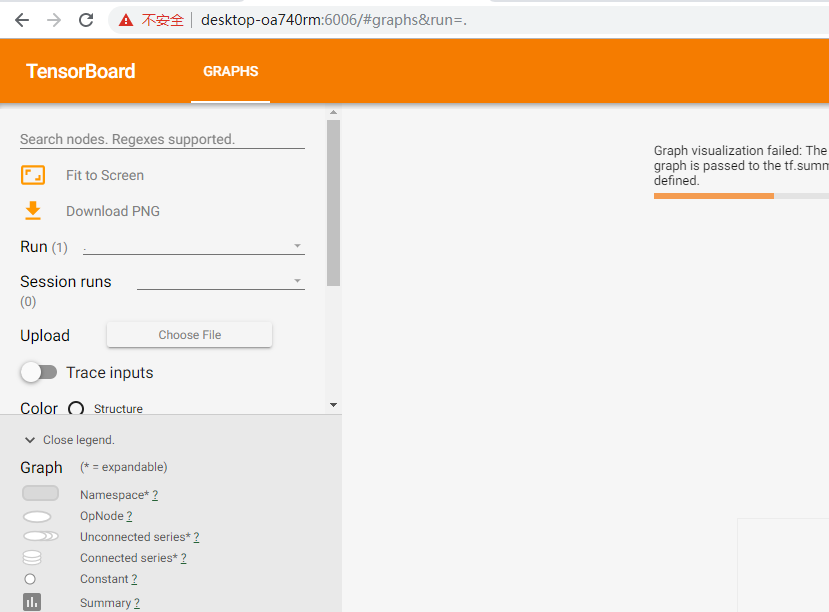#训练过程的可视化 ,TensorBoard的应用 #导入模块并下载数据集 import tensorflow as tf from tensorflow.examples.tutorials.mnist import input_data #设置超参数 max_step=1000 learning_rate=0.001 dropout=0.9 # 用logdir明确标明日志文件储存路径 #训练过程中的数据储存在E:\\MNIST_data\\目录中,通过这个路径指定--log_dir data_dir='E:\\MNIST_data\\' log_dir='E:\\mnist_with_summaries\\' mnist=input_data.read_data_sets(data_dir,one_hot=True) sess=tf.InteractiveSession() #本句的含义是使图可视化,sess.graph是对图的定义 #使用以上指定的路径创建摘要的文件写入符(FileWrite) file_write=tf.summary.FileWriter(log_dir,sess.graph) def variable_summaries(var, name): """对每一个张量添加多个摘要描述""" with tf.name_scope('summaries'): tf.summary.histogram(name, var) mean = tf.reduce_mean(var) #均值 tf.summary.scalar('mean/' + name, mean) stddev = tf.sqrt(tf.reduce_mean(tf.square(var - mean))) #标准差 tf.summary.scalar('stddev/' + name, stddev) # 最大值 tf.summary.scalar('max',tf.reduce_max(var)) # 最小值 tf.summary.scalar('min', tf.reduce_min(var)) tf.summary.histogram('histogram', var) def nn_layer(input_tensor, input_dim, output_dim, layer_name, act=tf.nn.relu): with tf.name_scope(layer_name): """为确保计算图中各个层的分组,给每一层添加一个name_scope""" with tf.name_scope('weights'): weights = tf.Variable(tf.truncated_normal([input_dim, output_dim], stddev=0.1)) variable_summaries(weights, layer_name + '/weights') with tf.name_scope('biases'): biases = tf.Variable(tf.constant(0.0, shape=[output_dim])) variable_summaries(biases, layer_name + '/biases') with tf.name_scope('Wx_plus_b'): preactivate = tf.matmul(input_tensor, weights) + biases # 激活前的直方图 tf.summary.histogram(layer_name + '/pre_activations', preactivate) activations = act(preactivate, name='activation') # 记录神经网络节点输出在经过激活函数之后的分布。 # 激活后的直方图 tf.summary.histogram(layer_name + '/activations', activations) return activations #构建回归模型,输入原始真实值(group truth),采用sotfmax函数拟合,并定义损失函数和优化器 #定义回归模型 x = tf.placeholder(tf.float32, [None, 784]) activations = nn_layer(x,784,10,"x") #训练模型 #使用InteractiveSession()创建交互式上下文tf会话,这里的会话是默认 #在tf.Tensor.eval 和tf.Operation.run中都可以使用该会话来运行操作(OP) sess = tf.InteractiveSession() #注意:之前的版本中使用的是 tf.initialize_all_variables 作为初始化全局变量,已被弃用,更新后的采用一下命令 tf.global_variables_initializer().run() for _ in range(1000): batch_xs, batch_ys = mnist.train.next_batch(100) sess.run(activations, feed_dict={x: batch_xs}) #运行tensorboard命令,打开浏览器,查看模型训练过程中的可视化结果, #在终端输入下命令: #tensorboard --logdir=E:\\mnist_with_summaries\\







【推荐】编程新体验,更懂你的AI,立即体验豆包MarsCode编程助手
【推荐】凌霞软件回馈社区,博客园 & 1Panel & Halo 联合会员上线
【推荐】抖音旗下AI助手豆包,你的智能百科全书,全免费不限次数
【推荐】轻量又高性能的 SSH 工具 IShell:AI 加持,快人一步